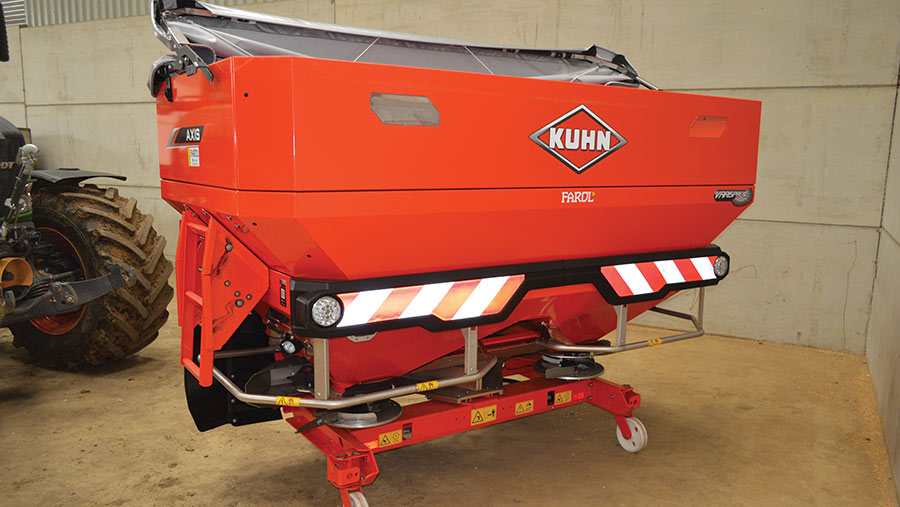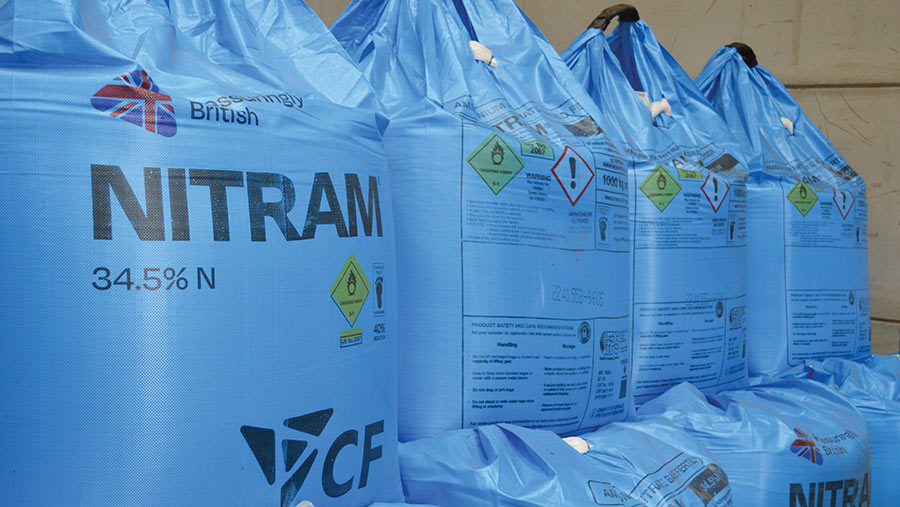What’s in Your Fertiliser Shed? Grower favours solid nitrogen for milling wheats
 © MAG/David Jones
© MAG/David Jones Will Paybody looks to solid ammonium nitrate as his main nitrogen fertiliser source.
It gives him the consistency he is looking for across the farm’s 36m tramline system on his family’s undulating Northamptonshire mixed farming unit.
He has tried solid urea in the past, but has not used it since the farm’s move to wider tramlines in 2015 from 24m previously.
He has considered liquid nitrogen but is concerned about possible leaf scorch and sprayer capacity at busy times of the year.
“We need the consistency of high-quality ammonium nitrate – for every bag to be the same – as we are spreading the product over a 36m width,” he tells Farmers Weekly.
See also: A wheat grower’s 4 tests to get nitrogen application rates spot on
Farm Facts
R J Paybody & Sons, Mill Farm, Maidwell, Northamptonshire
- Soils – Heavy clays to lighter sandy soils
- 1,600ha of arable cropping, plus grassland for a 1,200 ewe flock and 40 suckler cows and followers
- 800ha of winter wheat, with other crops including winter oats, spring barley, spring beans and peas
- Sprayer – Bateman 36m 4,000-litre capacity
- Spreader – Kuhn 50.2 with 36m spread
Breadmaking standards
The ammonium nitrate-focused fertiliser regime is producing 10t/ha-plus crops of winter wheat.
A foliar supplement on the wheat ears means the farm has met the 13% protein breadmaking standard for the past four seasons on its milling varieties.
Will appreciates the accuracy of a liquid nitrogen system, but is concerned about his sprayer capacity.
The farm’s 36m Bateman 4,000 litre capacity unit is kept busy with 1,600ha of arable cropping, so liquid is not really an option.
Half the farm’s arable area is growing winter wheat, with 800ha in the ground this season.
A quarter is in milling varieties such as Skyfall and Crusoe, and the rest in feed types such as Graham, Gleam and Extase (grown as a feed) on its soils which range from heavy clay to light sand.
He is using CF Nitram (34.5%N) this year which has spread well across the farm’s undulating arable land on his family’s Mill Farm, Maidwell, some 10 miles north of Northampton.

Will Paybody and Finley Hawkins © MAG/David Jones
Price swings
Many growers have struggled with the extreme fertiliser price swings over the past 18 months.
Ammonium nitrate was below £300/t before Russia invaded Ukraine and then rocketed to touch £900/t before falling back with new season supplies in late May starting at just over £300/t.
The only UK manufacturer of ammonium nitrate, CF has closed its Ince fertiliser plant in Cheshire, but is still producing Nitram from its remaining plant at Billingham on Teesside.
For the current season, the Northamptonshire farm has updated its spreader from the same manufacturer with a new Kuhn 50.2 twin-spinner model.
This has applied 180kg/ha of ammonium nitrate to feed wheats and 220kg/ha to milling wheats.
The one change this season is a switch away from ammonium nitrate-sulphur compounds applied early in the season due to shortages of these products caused by the disruption to European trading.
This reflected the high energy prices caused by the Ukraine conflict and resultant higher fertiliser prices.
Sulphur needs
This has prompted a move to applying polysulphate to winter wheats in February, to provide 60kg/ha of sulphur to the farm’s crops, and also a smaller amount of potassium.
This dense sulphur-potassium product has spread well in its first season of use on the farm, but necessitates another pass with the spreader compared with using ammonium nitrate-sulphur combined compounds.
Finley Hawkins, fertiliser business development manager with advisory and agronomy group Frontier, says one unintended advantage of this shortage is that early nitrogen levels can be more precise rather than be controlled by how much sulphur is needed.
“This frees up the nitrogen programme, as the early nitrogen delivered to the crop is not controlled by the application of the nitrogen-sulphur compound,” he says.
Finley emphasises that the focus on the farm has been on high-quality ammonium nitrate such as CF Nitram (34.5%N) prills or Yara Extran (33.5%N) granules, rather than opting for cheaper imported products.

© MAG/David Jones
Product shortage
The shortage of ammonium nitrate-sulphur products has prompted an increase in the first nitrogen dose in early March, up to 80kg/ha from 60kg/ha previously.
This helps cope with some signs of nitrogen lock-up as the farm establishes all its winter wheats by either direct drilling or minimum cultivations after chopping the previous crop’s straw.
This has seen crops slightly short of nitrogen in the early spring as the action of the straw breaking down sucks up some nitrogen which is then released later in the season.
The increased early nitrogen dose appears to have helped the crops overcome this minor problem this season.
The next dose of 100kg/ha of ammonium nitrogen is applied in early April, and then that is sufficient for the feed wheats, while the milling wheats get another 40kg/ha at the flag-leaf stage in mid-May.
Will points out that nitrogen levels are probably 30-40kg/ha below what might be expected due to the high use of organic manures on the mixed farm with all second cereals receiving chicken manure, biosolids or cattle manure.
The farm runs a 1,200 ewe flock and 40 suckler cows and fattens all the progeny.
Foliar nitrogen
For the milling wheats, a nitrogen-sulphur foliar treatment on the ear is applied at the milky ripe stage (GS71) to boost the grain protein up to breadmaker’s standard of 13%.
The farm uses 40litres/ha of Multi-N which supplies 14kg/ha of nitrogen and has helped the farm hit the milling premium in the past few seasons.
Despite success with this late foliar approach, Will is still wary of moving over to a total liquid nitrogen regime due to the potential for scorch.
This can easily occur in warm and windy conditions when rising air temperatures can affect the protective wax on wheat leaves.
“Multi-N has proved a consistent product for raising the grain protein levels for the milling wheats,” he says.
The product, from Frontier, has showed the ability to raise protein levels by 0.5-0.7% over many years of the company’s trials, and is proving more consistent and gentler on the crops than other foliar nitrogens, says Finley.
For the future, the farm is set to stick with high-quality ammonium nitrate, polysulphate and Multi-N on the milling wheats to give it the maximum flexibility to control nitrogen and sulphur to meet the requirement of the growing wheat crop.
In the next of our farm visits in this three-part series, we travel to Herefordshire where we talk to a grower using ammonium nitrate, protected urea and foliar urea on his feed wheats with a particular focus on avoiding nitrate pollution in the River Wye catchment area.

